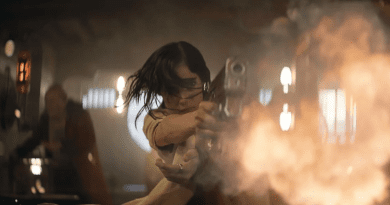1917 (2019) Review
One word: immersive. That’s pretty much sums up Sam Mendes’ highly-ambitious World War I epic, 1917.
The story itself — co-written by Mendes himself alongside Krysty Wilson-Cairns — is simple enough: Two young lance corporals (Dean-Charles Chapman’s Blake and George MacKay’s Schofield) are both assigned by their general (Colin Firth) to deliver an important message to the 2nd Battalion of the Devonshire Regiment that will save 1,600 British soldiers from walking straight to the Germans’ planned ambush.
At the hands of a lesser director, such a premise would result in nothing more than a typical war film. But 1917 is beyond that, thanks to Mendes’ bold creative decision in shooting the entire film to make it look like a continuous long take. Movies that utilise a single-take camera approach aren’t new at all, with Alfred Hitchcock’s Rope (1948) as well as others like Alexander Sokurov’s Russian Ark (2002) and Alejandro González Iñárritu’s Birdman (2014) being one of the prime examples.
And yet, it’s hard to deny that shooting a World War I film using such a technique is undoubtedly a refreshing change of pace from say, high shutter-speed camerawork seen in Steven Spielberg’s Saving Private Ryan (1998). Although 1917 does contain some cleverly-placed invisible cuts and one obvious blackout moment, the overall single-take shot is well put-together by editor Lee Smith.
Kudos also go to Roger Deakins’ magnificent lensing as he captures the horror of the war-torn landscapes regardless of the two lance corporals passing through the seemingly endless trenches or crossing the no man’s land filled with dead bodies and animal carcasses. Then, there’s the nighttime cinematography where Deakins has once again excelled in making excellent use of light and shadow to create surrealistic, yet nightmarish moments filled with silhouettes and illuminated flares and fire.

Back to Sam Mendes, utilising long single-take sequences in a war film is more than just a stunning technical marvel. Doing so also allows him to showcase the unpredictability of war seen from the two lance corporals’ point-of-views. Coupled with Thomas Newman’s dread-inducing score, this makes the movie all the more suspenseful and intriguing while maintaining a palpable sense of urgency as if you are in the middle of the action with them. I also have the opportunity to watch 1917 in an IMAX cinema and I must say the result is a remarkable cinematic experience.
While Mendes and his behind-the-scenes crew have done a great job in every technical department, he doesn’t get carried away with all the cinematic flourishes and thankfully never neglect in establishing the primary characterisations between the two lance corporals played by Dean-Charles Chapman and George MacKay. And he does so without the need of adding the burden of a backstory typically seen in most war films — a result that reminds me of the same minimalist storytelling technique seen in Christopher Nolan’s Dunkirk (2017). That said, both of their performances are top-notch.
Interestingly enough, Mendes even manages to turn the otherwise horror of the World War I that occurred over the course of its nearly two-hour running time with distinctively quiet moments. Whether it was the scene where the two lance corporals enjoying their downtimes in a flowery meadow or another one involving a French woman (Claire Duburcq) and a baby, Mendes shows that something beautiful can happen even in the unlikeliest places or moments.
As for the rest of the cast, familiar faces including Andrew Scott’s Lieutenant Leslie, Mark Strong’s Captain Smith, Benedict Cumberbatch’s Colonel Mackenzie and Richard Madden’s Lieutenant Joseph Blake all show up in respectively memorable cameo appearances.





